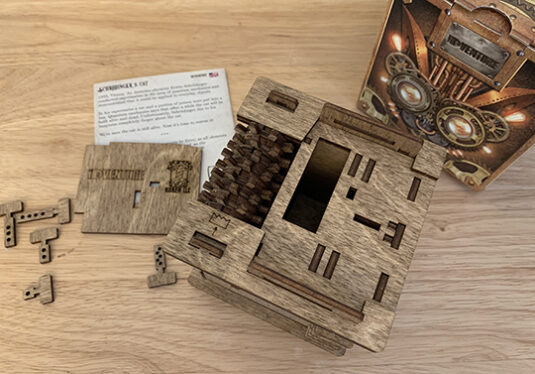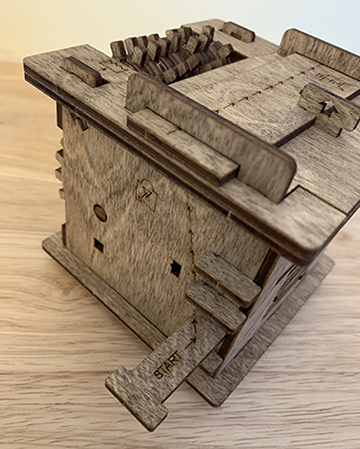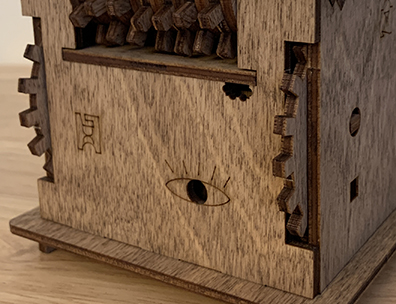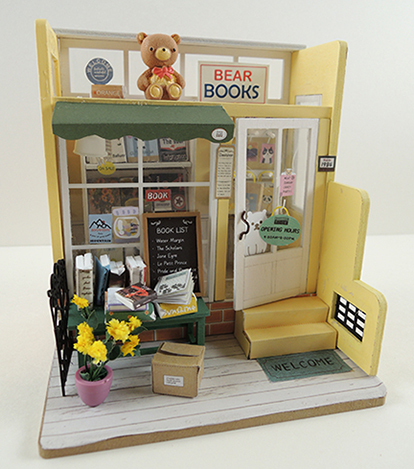 Readers might recall the miniature library kit that almost drove Katie to the edge of sanity in 2021. It took 12 months, 46 hours and countless grey hairs, but Katie finally completed it! Fast forward to 2022, and the discovery of the Mind-Find Bookstore kit by Rolife Hands Craft. How can we resist, right? This bookstore has a BEAR in it! So we decided to test the kit…except…now it’s MY turn to feel the agony and ecstacy of miniature building.
Readers might recall the miniature library kit that almost drove Katie to the edge of sanity in 2021. It took 12 months, 46 hours and countless grey hairs, but Katie finally completed it! Fast forward to 2022, and the discovery of the Mind-Find Bookstore kit by Rolife Hands Craft. How can we resist, right? This bookstore has a BEAR in it! So we decided to test the kit…except…now it’s MY turn to feel the agony and ecstacy of miniature building.
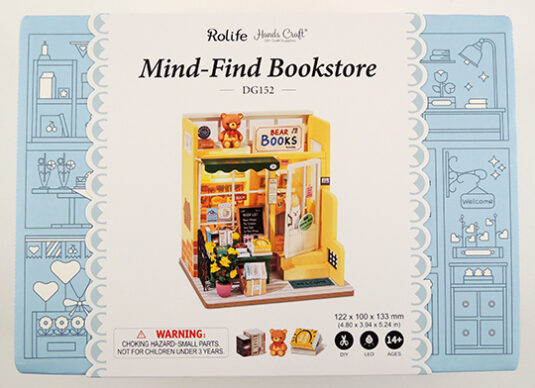
The Rolife kit is nicely packaged, and retails for around $20 on Amazon and Target. It is intended for ages 14 and up. That age range is absolutely correct. You need a steady hand and lots of patience to build it. I slowly unpackaged everything, wondering what I had gotten myself into. In the background, Katie chuckled evily.
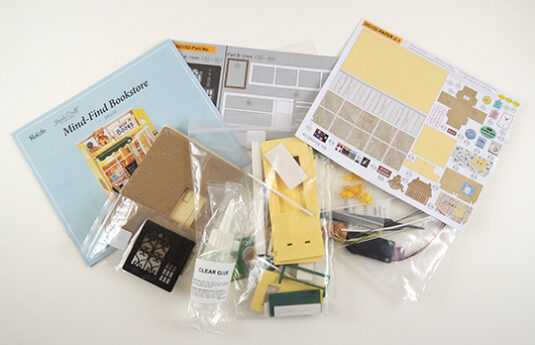
One thing I liked about the kit was that you could lay the pieces on the paper templates, matching up the numbers with the instructions. This allowed me to have everything in one place, without having to stop and hunt for pieces during the process. Fair warning: the print on the instructions is miniscule, and there’s a bunch of tiny little paper signs to cut out too. I used regular-sized scissors and fumbled through, but smaller craft scissors would have produced cleaner cuts for sure.

One thing I did NOT like about the kit was the glue. The nozzle was always gushing, which endangered the fragile pieces. I finally resorted to using a paperclip to brush the glue on all the teeny weeny surfaces.
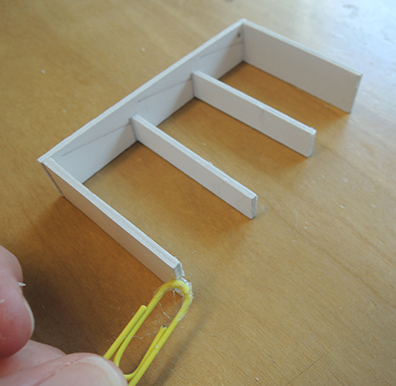
The kit also comes with a pair of plastic tweezers. I definitely had to use them! Not just for construction, but also setting up the interior of the shop. It was quite the adventure, folding the little bags, gluing the little handles on, and then navigating each of them on to the little slippery pegs!

There were a couple different types of books to construct as well. Some were just paper covers glued to foam pieces. Others were books you could actually open and turn the pages. Nice!
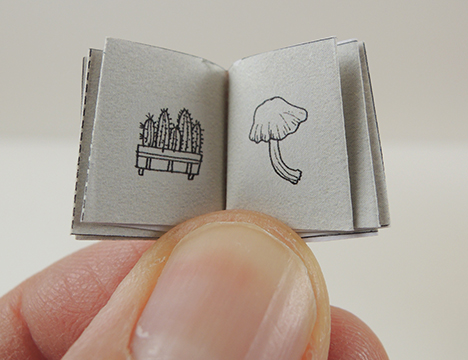 The advertised completion time for the kit is 3.5 hours. Well, it took me 5 hours and lots of complaining, squinting, moaning, and muttering quiet curses. At one point, I sent Katie a photo of my messy progress and bemoaned how crazy the kit was making me. She simply sent back this:
The advertised completion time for the kit is 3.5 hours. Well, it took me 5 hours and lots of complaining, squinting, moaning, and muttering quiet curses. At one point, I sent Katie a photo of my messy progress and bemoaned how crazy the kit was making me. She simply sent back this:

Like the kit Katie assembled, this little bookstore can be wired for lights. Buuuuuut I couldn’t figure out the “heat tube” part of the instructions, annnnnnd the little lightbox broke during construction. So I had to jerry-rig the bulb to the battery like some sort of miniature MacGyver. But in the end, there was LIGHT!
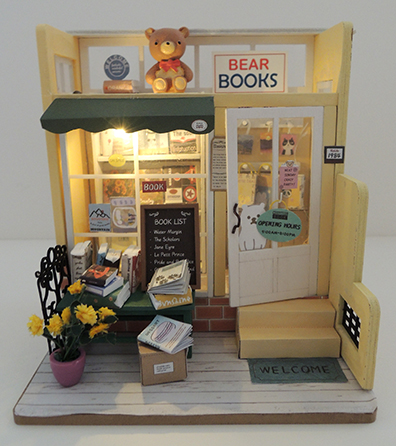 I would say the Mind-Find Bookstore kit by Rolife Hands Craft is mid-range in difficulty. If you are working on this with a kid, plan for lots of extra time and patience as most of the pieces are from scratch, the paper signs are small, and the instructions are a little vague. Ultimately, the results were cute, and this cheerful little bookstore will brighten any room or shelf!
I would say the Mind-Find Bookstore kit by Rolife Hands Craft is mid-range in difficulty. If you are working on this with a kid, plan for lots of extra time and patience as most of the pieces are from scratch, the paper signs are small, and the instructions are a little vague. Ultimately, the results were cute, and this cheerful little bookstore will brighten any room or shelf!



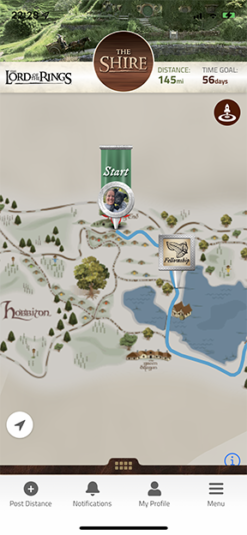 You either manually enter your miles (or kilometers) or you can sync your activities from your smartwatch or fitness tracker. Participants can walk, run, bike, swim, row – it doesn’t matter how you get there, it just matters that you are meeting your fitness goals and making every mile count. And you can see other participants on their journeys!
You either manually enter your miles (or kilometers) or you can sync your activities from your smartwatch or fitness tracker. Participants can walk, run, bike, swim, row – it doesn’t matter how you get there, it just matters that you are meeting your fitness goals and making every mile count. And you can see other participants on their journeys!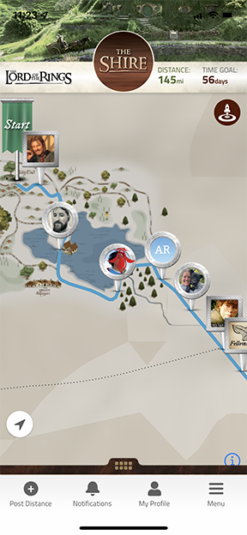 As you travel, you are sent digital postcards to commemorate the distance or to share information about your location. Here’s the first one I received:
As you travel, you are sent digital postcards to commemorate the distance or to share information about your location. Here’s the first one I received: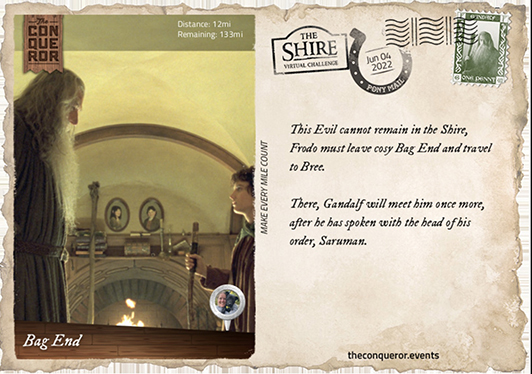
 Most of my miles were completed while walking with my own Samwise Gamgee, my pup Finley, who was more than happy to accompany me on this epic trail. Finley and I typically walk three miles a day around our neighborhood, but there were times when we found ourselves strolling down city streets or on a winding footpath in the woods. I also discovered the route I take on Princeton’s campus from the parking garage to Cotsen is exactly one-mile round trip. And here are me and Finley heading to an outdoor concert in Madison, WI this summer.
Most of my miles were completed while walking with my own Samwise Gamgee, my pup Finley, who was more than happy to accompany me on this epic trail. Finley and I typically walk three miles a day around our neighborhood, but there were times when we found ourselves strolling down city streets or on a winding footpath in the woods. I also discovered the route I take on Princeton’s campus from the parking garage to Cotsen is exactly one-mile round trip. And here are me and Finley heading to an outdoor concert in Madison, WI this summer. I left Bag End on June 2 and arrived in Bree on July 14, trekking 145 miles in 42 days. I thoroughly enjoyed checking in on the virtual map. The digital postcards were a nice added touch of encouragement, along with knowing I planted five trees. Here’s my finish screen:
I left Bag End on June 2 and arrived in Bree on July 14, trekking 145 miles in 42 days. I thoroughly enjoyed checking in on the virtual map. The digital postcards were a nice added touch of encouragement, along with knowing I planted five trees. Here’s my finish screen: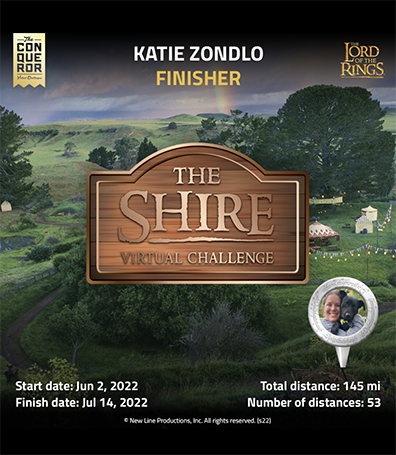
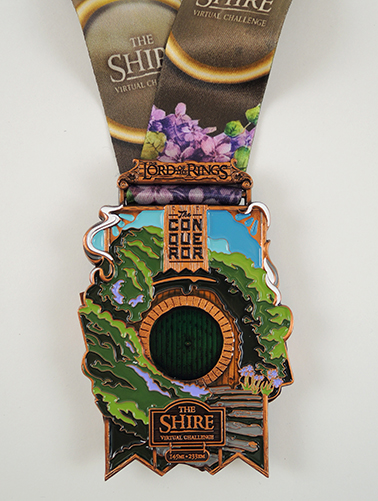 The back includes an envelope that contains the One Ring, which you are instructed to “Keep it Secret, Keep it Safe.”
The back includes an envelope that contains the One Ring, which you are instructed to “Keep it Secret, Keep it Safe.”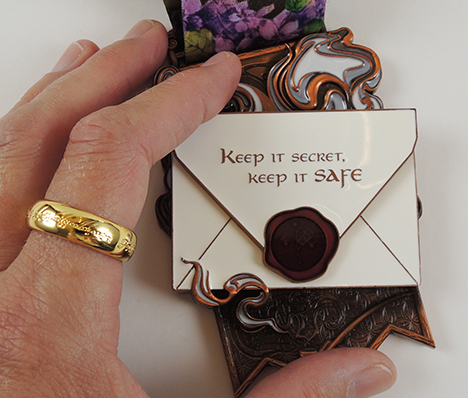 And yes, if you look closely, you can see that ring does have the famous Mordor inscription in Tengwar! The Conqueror Virtual Challenges are fantastic motivation to either kick-start a personal exercise plan or to encourage you to keep moving forward on the path to good health. And now that My Precious… I mean… the One Ring is in my possession, I must continue the journey to Mordor. I’m going to extend my subscription and further the adventure!
And yes, if you look closely, you can see that ring does have the famous Mordor inscription in Tengwar! The Conqueror Virtual Challenges are fantastic motivation to either kick-start a personal exercise plan or to encourage you to keep moving forward on the path to good health. And now that My Precious… I mean… the One Ring is in my possession, I must continue the journey to Mordor. I’m going to extend my subscription and further the adventure!
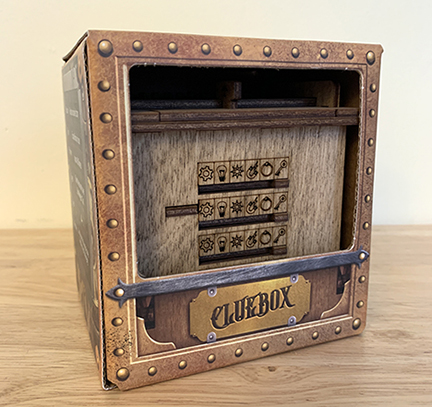 Always searching for more escape room inspiration, Katie was delighted when her mom sent her a dandy little escape challenge that fit right in the palm of her hand. Though it was small, but packed a mighty punch! Take it away, Katie!
Always searching for more escape room inspiration, Katie was delighted when her mom sent her a dandy little escape challenge that fit right in the palm of her hand. Though it was small, but packed a mighty punch! Take it away, Katie!